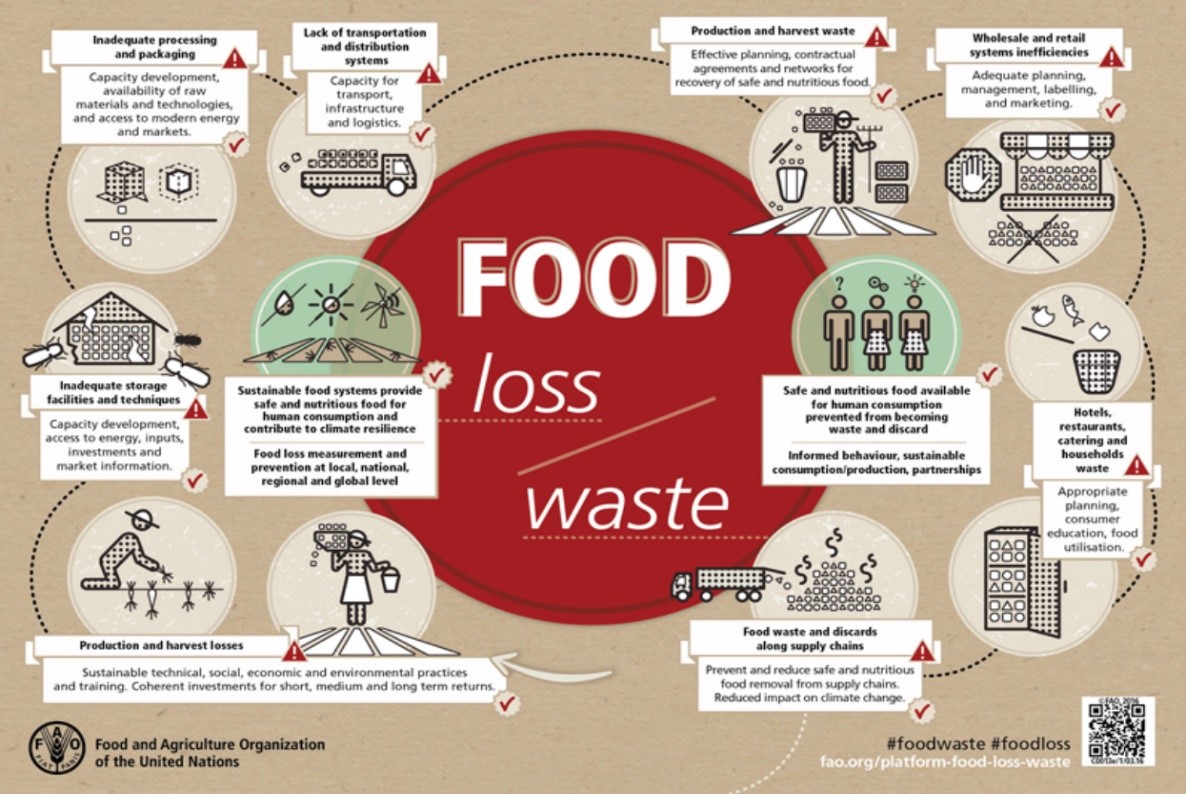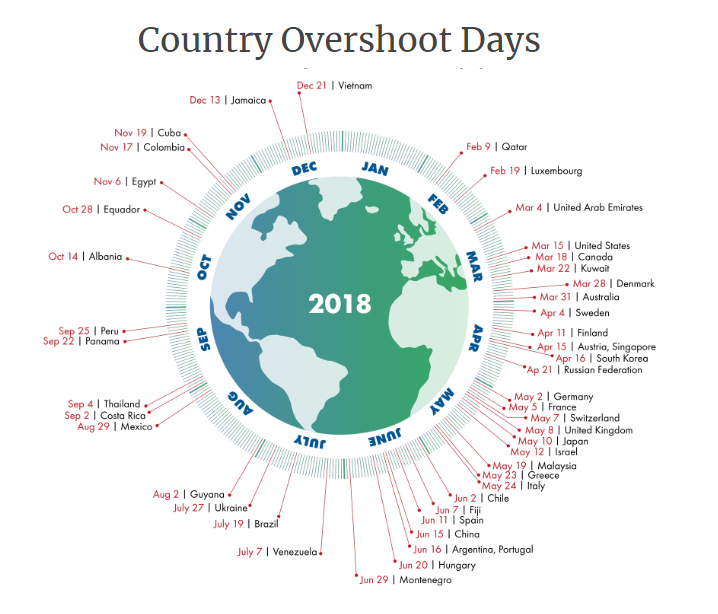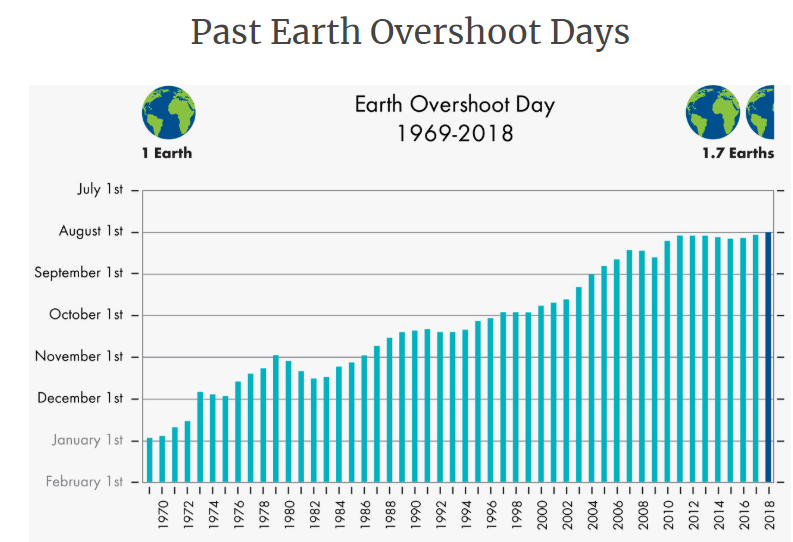Almost one-third of all food produced worldwide is discarded every year due to various causes and is not used. This corresponds to almost 1.3 billion tons per year (see FAO, 2011). Statistically, all food produced in Germany by the beginning of May end up in waste, which corresponds to around 18 million tons (see WWF, 2017). The food waste is of enormous proportions and seems unrealistic, in particular, with regard to over 800 million human beings who are still suffering from hunger (Welthungerhilfe, 2018). Even in an ecological context, many negative effects on the environment could be reduced as well. The following blog post clarifies relevant background information regarding this topic, puts the food waste in the context of the so-called ‘Earth Overshoot Day’ and wants to raise awareness on wasting less food.
Definition of food waste
Basically, food waste is divided into food loss and food waste. Food loss is the quantitative and qualitative decrease of food that was originally intended for human consumption, due to inefficiencies in the supply chain (Slow Food, p. 3). Food waste occurs downstream within the individual value chain stages, e. g. through supermarkets, catering or households, and is part of the food loss (see Fig. 1). A conceptual distinction is made because drivers and approaches are different for both categories (FAO, 2014).
Fig. 1: Difference between food loss and food waste (source: FAO, 2016)
Causes of food waste
The reasons for the high food waste are different. Below are a few examples:
- Harvest losses
- Transport losses
- Disturbed aesthetics and packaging damage (e. g. in supermarkets)
- Incorrect storage / overlay
- Overproduction (e. g. in catering)
- Lack of awareness and lack of sensitivity
- Marketing strategies (e. g. incentives – ‘buy two for the price of one’)
- Cultural backgrounds
Food waste impacts
Consequences occur within all stages of the value chain and are ecological, social as well as economical:
- Increased greenhouse gas emissions (e. g. CO2, methane, nitrous oxide) – in Germany, for example, almost 22 million tons of CO2 equivalents could be saved annually through avoidable food losses and food waste (see WWF, 2015, p. 52ff.)
- Increased water consumption
- Faster soil erosion
- Increased land usage – in Germany, for example, the land usage footprint could be reduced by 2.6 million ha due to avoidable food losses and food waste (see WWF, 2015, p. 54)
- Wasted energy consumption
- Wasted workforce
- Economic consequences (e. g. increase in food prices due to resource scarcity or less availability)
- Indirect consequence: also forms of hunger (see Welthungerhilfe, 2018; Link to SDG 2 – End hunger)
Food waste in the context of the ‘Earth Overshoot Day’
The ‘Earth Overshoot Day’ marks the date when all humanity has used more natural resources than the planet can reproduce in the entire year. This year, the day already was on 1st August 2018 (see overshootday.org, 2018). Country-specific this day varies (see Fig. 2).
Fig. 2: ‘Country Overshoot Days’ (source: overshootday.org, 2018)
In this context, fighting and reducing food waste could be a driver for moving the ‘Earth Overshoot Day’ backwards. This, in turn, would be an indicator that appropriate measures are in place and that policies are effective. However, the fact that the ‘Earth Overshoot Day’ is consistently earlier each year (see Fig. 3), the opposite can be assumed here.
Fig. 3: ‘Earth Overshoot Days’ since 1970 (source: overshootday.org, 2018)
What measures are in place and what can be done by everyone?
At the organizational level, there are already some initiatives that address this challenge and try, for example through initiated projects, to reduce the progressive food waste and thus limit the negative effects:
- WWF (e. g. information work, petitions with the intention that they have a political impact)
- FAO (e. g. Global Initiative on Food Loss and Waste Reduction)
- SlowFood (e. g. projects and action days)
- Welthungerhilfe (e. g. factsheet, tips, information work)
- Federal Center for Nutrition
- And many more
To tackle this problem, actors at every level are required to make some efforts (e. g. politics, business, consumers). Given that only up 35% of loss[1] happen at the end consumer level (in Europe, North America and Oceania), the efforts should be first made on businesses and politics. Still, end consumers can do their share. Here are some tips and actions listed:
- Moderate laws and regulations (political measure)
- Increase the integration of social organisations which take overproduced food from restaurants and supermarkets
- If the date has expired for a few days, check the quality of the product yourself before throwing it automatically
- Purchase lower rations of better quality
- Buy food that is produced regionally to reduce CO2 emissions and support local trade
- Give leftovers to neighbours or use initiatives such as foodsharing.de or essensretter.de
- Set up a different storage (older products before in the shelves)
- Try to lower your consumption of meat, fish and dairy products (means lower land usage)
- Plan your meal schedule in advance and buy accordingly
- etc.
If you are interested in the topic and would like to get further information, please contact us by e-mail via or by phone on 08192.99733-20.












